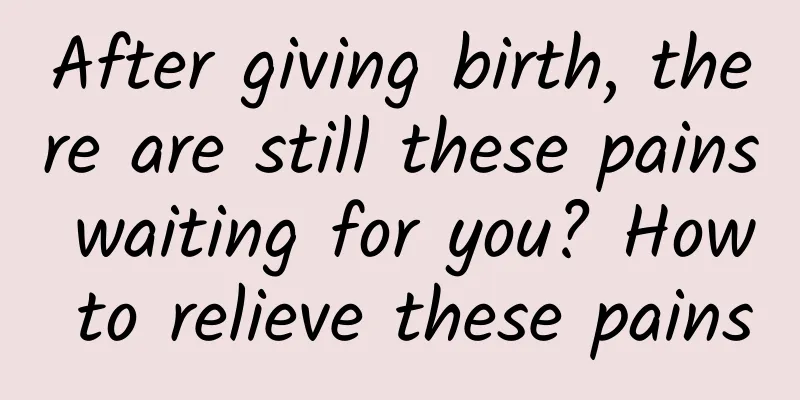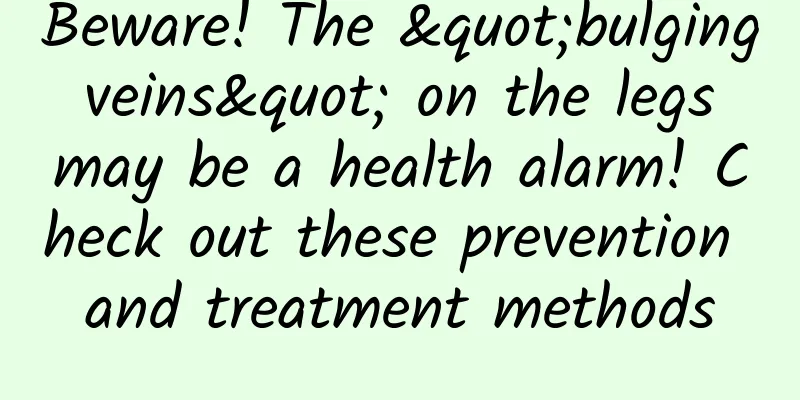After giving birth, there are still these pains waiting for you? How to relieve these pains

|
We know that the pain during childbirth is really painful, and we think that the pain ends after the baby is born. However, we don’t know that the birth of the baby only ends the labor pain. Some pain will only occur after the birth, and it will last for a while. Therefore, many people are scared by the pain during childbirth and dare not give birth. But in fact, childbirth is not only painful when you give birth, but there are still several pains waiting for you after you give birth. What is the pain? Let’s take a look at it with Encyclopedia Knowledge Network. After giving birth, there are still these pains waiting for you The labor pains during childbirth are only temporary. After they are over, there will be some pain that will occur after childbirth and will continue for a while. Although these pains are nothing compared to the labor pains during childbirth, pain is always uncomfortable. Therefore, women must be aware of the pains they will experience after childbirth so that they can be mentally prepared to face them. 1. Uterine contraction painDuring pregnancy, the uterus will grow larger and rise to the navel. After the baby is born, the uterus will slowly descend to its original position and shrink to its original size. Pain will occur during the contraction and descent of the uterus. In addition, if the uterus does not contract smoothly during contraction, it may cause postpartum hemorrhage. In order to avoid this phenomenon, medical staff will regularly squeeze the uterus to discharge the blood in the uterine cavity. The pain caused by uterine contractions plus the squeezing of the uterus by medical staff may make the mother feel unbearable pain, but this pain is only temporary. Mothers must hold on, otherwise it will be worse if postpartum hemorrhage occurs. Fortunately, this pain will not last for a long time and will disappear naturally 2-3 days after delivery. 2. Painful urinationMany mothers will have an operation during childbirth, which is episiotomy. Before the episiotomy, the doctor will first give the mother a local anesthesia. Before the anesthetic wears off, the mother may not feel the urge to urinate temporarily. However, when the anesthesia wears off, there is a wound in the mother's perineum, so the mother's perineum may swell. If the wound is not properly cared for, it may also hurt, so the mother will feel pain when urinating. Some mothers even don't urinate unless they can't hold it anymore because they are afraid of pain. Holding urine is a bad habit. If you hold it too much, the bladder will swell and may cause urinary tract infection, and even affect the recovery of the uterus. In order to reduce the pain caused by urination, mothers can flush the urethra with warm water before urinating, wash the genitals with warm water after urinating, or use a warm towel to apply heat to the lower abdomen, touch the bladder, stimulate the contraction of the bladder muscles, and exercise the bladder muscles more. This way, mothers will not feel too much pain when they use the bladder muscles to urinate. Why is this happening? The reason may be that the pain in the wound makes the new mother afraid to urinate, or it may be that the fetal head compresses the pelvic floor during delivery, causing temporary paralysis of the pelvic floor muscles including the bladder muscles, resulting in difficulty in urination. How to deal with it? You should drink plenty of water after childbirth and consciously urinate as soon as possible. If you feel difficulty urinating, you should apply hot compresses to the perineum, or turn on the faucet to stimulate urination with the sound of running water. If you feel that your bladder is swollen and you want to urinate, but you cannot urinate, you can also gently press the lower abdomen with your hands when urinating to help urination. If these methods are ineffective and you have not urinated for 6 hours after childbirth, you should ask a doctor for treatment. You can inject neostigmine intramuscularly or acupuncture acupoints. If it still does not work, you should place a catheter to prevent the bladder from over-expanding and urine from being retained for a long time, leading to urinary tract infection. It should be noted that although some women have urinated within 6 hours after delivery, they cannot drain the urine completely due to perineal edema and bladder muscle paralysis, which will cause chronic urinary retention, affect uterine contraction, and increase vaginal bleeding. Therefore, you should pay attention to the amount of urine you urinate each time after childbirth. If the amount of urine you urinate each time is not much, you should tell your doctor. The doctor will check the height of the uterine fundus and whether there is a bulging bladder in the lower abdomen of the mother, and take timely treatment measures. 3. Perineal wound painAlthough not every mother will have an episiotomy during childbirth, as long as it is a normal delivery, the mother's perineum will be swollen when the baby comes out of the mother's vagina, so the mother's genitals will feel a sense of falling after delivery. If the mother has a cut during delivery, the pain will be more obvious. In this regard, postpartum care must be extra careful, maintain good hygiene habits, use clean warm water to wash the genitals, and change the underwear every day to avoid bacterial infection. Why is this happening? This is because during childbirth, the pelvic floor muscles will be strained to a certain extent, some muscle fibers will be broken, or, due to the large fetus and the tension of the perineum, perineal tearing will occur. In some cases, in order to avoid severe perineal tearing, the midwife will also perform an episiotomy, which will cause perineal wound pain after delivery. In another case, the sutures used to suture the perineal wound will cause pulling pain in the perineal wound after drying. In this case, the pain will be significantly relieved after the sutures are removed (or the sutures are absorbed). How to deal with it? As the edema of the perineal wound disappears, the pain will be significantly relieved. If the new mother reacts significantly to the sutures, physical therapy can also be performed to promote local blood circulation and help the intestinal line absorption, which will also relieve the pain of the wound. It should be noted that if the wound is severely painful within 24 hours after delivery, accompanied by a feeling of anal swelling, the doctor should be asked to check the wound immediately to see if there is a hematoma around the wound. When caring for the wound, the following points should be noted: wash the wound suture with clean warm water (or the medicated lotion provided by the hospital) 2 to 3 times a day; after washing, gently dry the genitals with disinfectant paper or cotton wool; wash the vulva with clean water after defecation to keep the wound clean and dry to prevent infection; if the wound is on the left side, sleep on the right side, and vice versa; if the physical condition permits, pelvic floor muscle exercises can be performed to stimulate blood circulation in the genitals, thereby promoting wound healing. 4. Breastfeeding painThe best food for a newborn baby is none other than breast milk. Most mothers can’t provide much breast milk in the first few days after giving birth, but don’t worry, the baby can stimulate the secretion of milk when sucking breast milk. The mother may not be used to breastfeeding the baby at the beginning, so she may feel pain when the baby sucks. Once the mother gets used to breastfeeding, the breastfeeding pain will naturally disappear. In addition, breast care after childbirth is very important. If it is not taken care of well and there is a lot of milk, milk engorgement may occur. In this case, the breasts must be massaged to clear the milk ducts. This massage can be very painful. Why is this happening? The mammary gland is composed of fat, mammary gland alveoli and ducts. Under the action of estrogen during pregnancy, the mammary gland begins to proliferate, and the level of placental prolactin continues to increase, preparing for postpartum lactation. After delivery, most mothers will secrete colostrum, and a large amount of milk is generally secreted 2 to 3 days after delivery. At this time, the mother will have obvious breast pain, the surface temperature of the breast will rise, and sometimes you can see full veins, which is a sign of the beginning of lactation. Generally, after 7 days after delivery, when the milk is unobstructed, the pain will be relieved to a certain extent. How to deal with it? Start breastfeeding early and breastfeed frequently to clear the mammary ducts as soon as possible and discharge the milk as early as possible; empty the breasts actively and let the baby suck out all the milk as much as possible. If the baby drinks too little milk, you can squeeze out the milk with your hands or a breast pump; before breastfeeding, apply a warm towel to the breasts, or gently massage the breasts from all sides toward the nipples with your hands to promote smooth milk flow; wear a suitable bra to lift the breasts to facilitate blood circulation in the breasts, thereby reducing pain; if the breasts are severely swollen or painful or red, swollen, hot, or painful, you need to go to the hospital in time. 5. Constipation and anal painThere is a high possibility that mothers will suffer from constipation after giving birth, because giving birth is too tiring. Mothers need a long period of rest. If they lie down for a long time, the gastrointestinal motility will be weakened. If the daily diet lacks fiber, it will easily lead to difficulty in defecation. In severe cases, thrombosed external hemorrhoids may even occur. The symptoms of this disease are pain in the anus and a noticeable feeling of anal swelling. Although mothers need rest, they should not stay in bed all day. Even if they cannot go out, they can walk around the house. Their diet should be nutritionally balanced and they should eat more vegetables. They can sit on the toilet at a fixed time every day to prepare themselves for bowel movements, so as to minimize the possibility of constipation. |
>>: What should you do if you meet a once-in-a-lifetime guy on a blind date?
Recommend
Is it effective to take emergency contraceptive pills after 72 hours?
"Medicine is three-point poison" I beli...
What are the signs of pregnancy on the ninth day after ovulation?
Everyone knows that if you want to get pregnant q...
What does it mean when the cervical curvature becomes straight? Can it be restored?
This is the 3441th article of Da Yi Xiao Hu With ...
Bleeding the next day after curettage after incomplete medical abortion
Medical abortion mainly involves taking medicatio...
Female lower back pain
In life, many women often feel lower back pain. T...
My period hasn't come for 5 days.
If menstruation has not come after 5 days, this i...
"Health from eating" series | The weather is cold and dry, check here for winter food supplements
As the old saying goes, "Tonify in winter, f...
Cheetah Global Think Tank: China App Market Report for Q3 2018
I watched the popular TV series "Startup Era...
Why does leucorrhea turn yellow and have an odor?
There will be constant problems with leucorrhea i...
Can I eat papaya during menstruation? What are the benefits?
Female friends should pay close attention to thei...
How long does it take for ovulation to occur after the ovulation test paper shows a positive result?
In order to achieve the best time for conception,...
Diet for 10 days after hysteroscopy
Hysteroscopic and laparoscopic surgery is always ...
This disease loves to haunt strong women!
Due to the unhealthy lifestyle of most women nowa...
Can you get pregnant if you have sex after your period?
Whether you are a mother who is preparing for pre...
What preparations should be made before medical abortion
Generally, women born in the 1990s choose to have...









